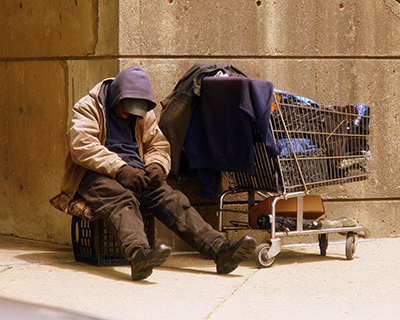I READ ABOUT HUGO Landecker in the local press. He’s the San Rafael resident who has a controversial plan to reduce, if not eliminate, homelessness in the city where he and his wife, Cynthia, have lived for 48 years. Last Tuesday, I met with him to hear him out. “This is the first time I’ve done anything this big,” Landecker told me. “It could be a model that would solve homelessness nationwide.”
A recent nationally mandated census indicated that more than 1,300 homeless people are in Marin, most of them in San Rafael. “That’s up 40 percent from 2013,” Landecker pointed out. “They range from truly needy to drug and alcohol addicted to young people who have lost their way to the mentally and physically handicapped.”
According to him, the homeless in San Rafael are drawn to the Ritter Center, a nonprofit off Second Street offering showers, mailboxes and medical services, and St. Vincent de Paul’s dining room on B Street, which serves up to 400 free meals a day, 365 days a year. “But like so many well-meaning countywide efforts,” Landecker insists, these facilities are “only nibbling away at this enormous problem; they’re not solving it. You might even call them enablers.”
To be brutally direct, Landecker would like to see both endeavors, over time, closed, or at least relocated out of downtown San Rafael. His overall goal, he maintains, is to see the homeless become productive members of society.
In the years he’s been observing homelessness in San Rafael, Landecker has gathered an online following of nearly 500 people who for the most part agree with him. “Every day of the week, for over three years I’ve sent out an email with an update on San Rafael’s growing problem,” he says. Those receiving his briefings include not only residents but county supervisors, state legislators and Ritter and St. Vincent de Paul officials. A typical email will generate 20 to 30 replies, some agreeing, others disagreeing with his information and claims. However, in June he sent out one that drew “nothing but a positive response,” he says: a message proposing a solution to the homelessness problem not only in Marin, but also in Sonoma County and possibly even beyond.
“Think of a Sonoma/Marin homeless campus that doesn’t have to be built, because it already exists,” Landecker’s email said. “The Sonoma Developmental Center presents the opportunity of a lifetime for those hoping to recover from homelessness.” The center — with numerous buildings on 1,660 acres near the town of Glen Ellen — has been serving people with developmental disabilities for 50 years and is slated for closure by 2018, as its population has dropped to fewer than 400. “The state has allocated $50 million to relocate those patients,” Landecker wrote.
To help homeless people get to the Sonoma center, he proposes this plan: “Each city in both counties would have small intake offices where those wanting help would check into and receive free transportation.” He envisions the place as “a park-like facility offering food, shelter, medical assistance, drug and alcohol recovery programs and job training — all of the services that are currently being provided by numerous nonprofits such as Ritter Center and St Vincent.” Landecker has toured the developmental center and presented his general concept to State Sen. Mike McGuire’s staff, as well as Marin County Supervisors Damon Connolly and Katie Rice. He is serious about the idea, devoting many waking hours to exploring and advocating it.
I can hear you now, saying, “Those people won’t go anywhere they don’t want to go.” But if the services that are now provided them are no longer available, you might see a significant change in attitude. I can see how some would say these well-meaning nonprofits are not solving this multifaceted and growing problem; they are only accommodating it. Something must change before we lose our downtown businesses and neighborhood parks to those labeled “homeless.” Hugo Landecker’s concept definitely merits looking into. That’s my point of view. What’s yours?
Email [email protected].
The views and opinions expressed in this article are those of the author and do not necessarily reflect the policy or position of Marin Magazine and its staff.


